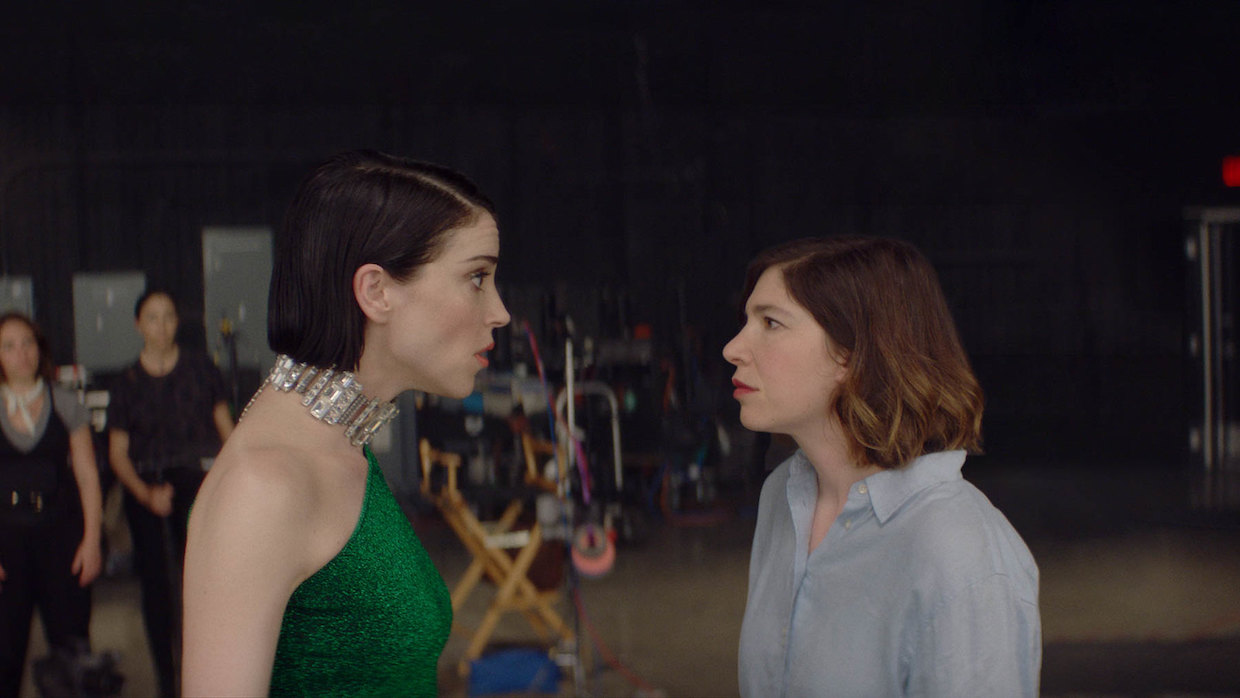 Back to selection
Back to selection
“Think Judd Apatow Meets The Holy Mountain“: DP Minka Farthing-Kohl on The Nowhere Inn
 Annie Clark and Carrie Brownstein appear in The Nowhere Inn by Bill Benz (courtesy of Sundance Institute)
Annie Clark and Carrie Brownstein appear in The Nowhere Inn by Bill Benz (courtesy of Sundance Institute) Bill Benz’ directorial debut The Nowhere Inn explores the absurdity of fame and persona, centering around the real dichotomy between musician Annie Clark and her stage presence as St. Vincent. Carrie Brownstein plays a director making a documentary about Clark’s life, but eventually finds St. Vincent overtaking the narrative and decimating the conventions of reality. Starting out by scraping by in Philly and eventually tackling an ambitious metacritical film, DP Minka Farthing-Kohl speaks to Filmmaker about her experience on the set of The Nowhere Inn.
Filmmaker: How and why did you wind up being the cinematographer of your film? What were the factors and attributes that led to your being hired for this job?
Farthing-Kohl: When I first moved to Philly, I lived in a 100 year old abandoned candy shop without heat or gas and I didn’t know anyone. After a couple of days, I started knocking on the doors of rumored friends of friends carrying a towel and an onion, saying: “What are we making for dinner, mind if I take a shower?” Many people were quizzical but Bill let me in and we’ve been friends ever since.
Filmmaker: What were your artistic goals on this film, and how did you realize them? How did you want your cinematography to enhance the film’s storytelling and treatment of its characters?
Farthing-Kohl: Carrie Brownstein and Annie Clark wrote a wonderful screenplay that has this massive tonal arc; it starts playful and slowly peels back its layers into something darker and more surreal. Think Judd Apatow meets The Holy Mountain. We wanted to see what we could do to push those ideas forward while bringing a voice to the film that resonated with the style and sensibilities of our leads.
Filmmaker: Were there any specific influences on your cinematography, whether they be other films, or visual art, or photography, or something else?
Farthing-Kohl: Everyone brought different ideas and references to the table, which were discussed and built upon until they became something that got everyone excited. First and foremost, it was the music of St. Vincent and Sleater-Kinney that drove the tone. We also talked a lot about Nicholas Roeg, specifically Performance and The Man Who Fell to Earth, Peter Greenaway’ s The Cook, the Thief, His Wife & Her Lover, the photography of Cindy Sherman and the paintings of Hieronymus Bosch and Philip Gustafson.
Filmmaker: What were the biggest challenges posed by production to those goals?
Farthing-Kohl: It was a rambling road movie that takes place in different venues, cities and hotels across the country, which meant we never return to a location twice. Production did an incredible job of finding locations that could act as multiple places and schedule it in a manageable way. Even with that said, it was still daunting in the volume of looks we had to create over 15 days.
Filmmaker: What camera did you shoot on? Why did you choose the camera that you did? What lenses did you use?
Farthing-Kohl: The story is constantly bouncing back and forth between fiction and non-fiction. To establish the different perspectives we used different aspect ratios and formats to make sure the audience knew exactly who’s lens they were watching the story through. To accomplish this, we shot Alexa with various Panavision anamorphics, Primo lenses and a 416 loaded with various Kodak stocks, Zeiss Superspeeds and a Canon 6.6-66 zoom.
Filmmaker: Describe your approach to lighting.
Farthing-Kohl: It was a constant collaboration with Bill Benz the director, Garrett Ian Williams, our gaffer, Shun Goldin, our key grip, Grace Alie, our production designer and Ian J. Putnam our 1st AD. Our approach was in response to the story and location. Initially, we started with a more formal look and feel, and as the story and tone begin to alter we move into an ethereal space. It was all in reaction to where we had come from, where we were and where we were going.
Filmmaker: What was the most difficult scene to realize and why? And how did you do it?
Farthing-Kohl: Doing a daytime poor person’s process trailer in a limo was a challenge. The schedule and budget didn’t allow us to return to the desert to shoot the scene where it takes place. So we leaned into the story and treated the windows to blow them out. It works for the story but wasn’t as initially imagined.
Filmmaker: Finally, describe the finishing of the film. How much of your look was “baked in” versus realized in the DI?
Farthing-Kohl: We worked with colorist Freddie Bokkenheuser to build LUTs for our various looks which we then applied and modified on the day with our DIT Ryland Jones. Both were integral in creating and settling in on a look during production. This allowed us to time to finesse the rest of it in the grade.
TECH BOX:
Film Title: The Nowhere Inn
Camera: ARRI Alexa Mini, Arri 416
Lenses: Various Panavision Anamorphic, Panavision Primos, Zeiss Super Speed (S16) Lenses, Canon 6.6-66 T2.7
Lighting: All of the above.
Processing: Fotokem Digital & Film
Color Grading: Freddie Bokkenheuser
